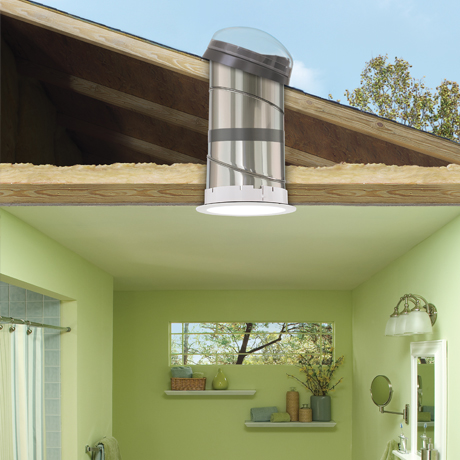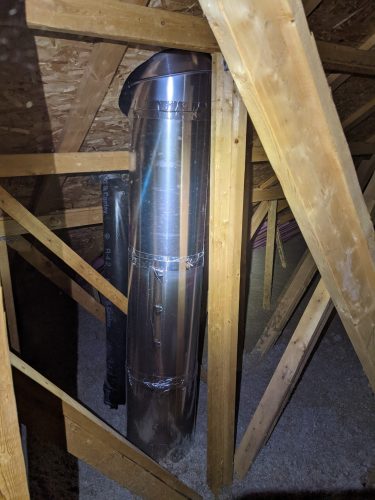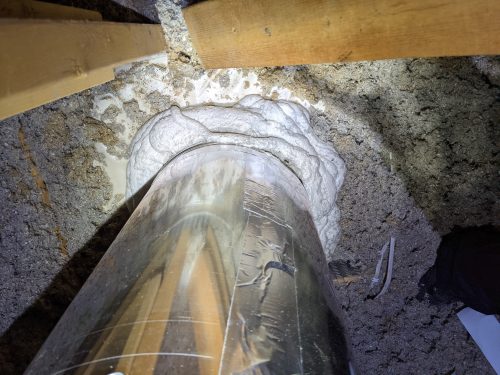My official position on solar tubes: they rock. They’re easy to install, they’re inexpensive, they bring in tons of light, and they don’t cause problems. For the most part.
What’s a solar tube?
A solar tube is a fantastic alternative to a traditional skylight. It consists of something installed at your roof to allow light in, a reflective tube to bring that light into the right room, and a diffuser installed at the ceiling. I boosted the image below from Velux, showing a nice cutaway view of their Sun Tunnel® Tubular Skylight.
Different manufactures have different names for these things, but solar tube is a generic term for these products.
The installation process
Skylights are a ton of work to install, primarily because you need to frame in a ceiling shaft. On the other hand, solar tubes are a relative piece of cake. You simply figure out the placement of things, you cut a hole in the roof and install the bubble, cut a hole in the ceiling and install the diffuser, then connect the two together with a tube. Here’s a great video showing how to install a solar tube from start to finish:
You’ll notice they called it a tunnel skylight, but nobody actually says that. It’s a solar tube.
I’ve installed the Velux brand of solar tubes in dark, windowless bathrooms at my two previous houses, and I recently installed a solar tube at my current house in a dark, windowless bathroom. The installation instructions in the video above are right on point, and it really is as easy as she makes it look, assuming you’re not working on a steep roof.
I happened to install my last one on a fairly steep roof (9/12), and I did it on a very windy day when it was 30° outside. I was cold to the core by the time I was done working outside, and I had stuff blowing off the roof. If I ever install another one, I’ll do the roof work on a warmer day with less wind.
What are the potential problems?
I don’t have much to complain about when it comes to a solar tube, as long as it’s properly installed. If you get the flashing right at the roof, you won’t have to worry about roof leaks. Just follow the manufacturer’s installation instructions. I don’t think I’ve seen a solar tube leak during my entire inspection career.
The one concern I have with solar tubes is that they could contribute to ice dams. If you live in a cold, snowy climate, this is a thing. You have the potential to transfer some heat from your ceiling to the roof decking, and that can lead to melting snow. If you have a steep-sloped roof and your solar tube is penetrating the roof fairly high up, this will greatly reduce the potential for ice dam problems. The closer your ceiling is to your roof deck, aka the less space you have in your attic, the greater the potential for ice dam issues.
Insulation and air sealing
To help reduce the potential for ice dam problems, it’s a good idea to have the entire tube insulated, preferably by a professional. Of course, that would move this project outside the realm of DIY, but if you’re hiring a professional to install a solar tube, this is something they ought to recommend. Insulating the tube with foam insulation is definitely the best way to go. Wrapping fiberglass batts around the tube would be nearly worthless, so don’t waste your time with that.
For my current home, I have a very tall attic and chose not to insulate my tube in the attic. I also skipped this at my last house, and I haven’t had issues with snow-melt at either one.
What’s extremely important, however, is to make sure that the intersection between the ceiling and the light diffuser is 100% air-sealed. You don’t want any air leaking up into the attic space around this opening, because these attic bypasses can lead to a long list of attic problems. To help make sure that everything was properly air-sealed, I went nuts with the expanding foam on every one of my installations.
Heat gain
Heat gain from solar tubes is negligible. If you stand in the sunlight below a skylight shaft, you’ll feel the sun’s warmth, even during the winter. Not so for a solar tube. Even on a hot day, you typically don’t experience any noticeable heat radiating from the ceiling diffuser on a solar tube. Conversely, they don’t allow nearly as much heat to escape the home during winter.
Podcast discussion
Bill, Tessa, and I spent a lot of time discussing solar tubes during one of our podcasts last year. Here’s that episode:




Titus
July 30, 2021, 2:19 pm
Very Interesting and a Great Idea! My biggest concern when reading was the insulation aspect which you did talk about but I still have a hard time with the fact that it would not transfer a lot heat from the attic into the home. Foam insulation would definitely be the way to go but why do you dislike the idea of wrapping around Fiberglass Batts so much? When you start talking about installing something that is going through the roof I think it is beyond DIY just because the ramifications of a mistake could be very costly but perhaps one who has really done their home work can do it correctly. Thank you for the article. http://www.homeinspectorelpasotx.com
Reuben Saltzman
July 30, 2021, 3:00 pm
Hi Titus, the issue with wrapping fiberglass insulation is that this type of insulation is designed to be encapsulated on all six sides. Check out this blog post for more information on that: https://structuretech.com/skylight-shaft-insulation/. It’s not to say that this would be harmful, but more that I don’t think it would be worth the effort.